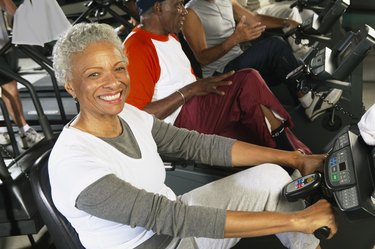
The recumbent stationary bike is the one that has a backrest with the pedals out in front. The main advantage of using a recumbent bike over the conventional upright model is it places less stress on your lower spine. Recumbent bikes also produce less strain on your arms, wrists and neck. Because it has the backrest in conjunction with a bucket seat, it also offers a more comfortable ride. If you are new to this bike, learn some tips to make your workouts successful.
Dynamic Stretches
Video of the Day
When you pedal on the recumbent bike, you work multiple muscles and activate multiple joints in your lower body. If you do not adequately loosen up before stepping onto the bike, you risk suffering an injury to your muscles and connective tissue. To prevent this from happening, spend five minutes doing dynamic stretches which are done in motion. Knee highs, walking lunges, side bends, alternating toe touches, leg swings, ankle bounces and trunk rotations are examples of dynamic stretches. As you perform the dynamic stretches, focus on moving smoothly and gradually increasing your range of motion on each repetition.
Video of the Day
Seat Adjustment
Before you start spinning the cranks on the bike, you must be properly set up. Once you sit down, place your feet on the pedals and spin the cranks a few times. When doing this, pay attention to the extension of your knees. You should have a slight bend in your knee when your leg is on the back side of the crank. If it is not in this position, slide your seat forward or back to get it there.
Light Warm-Up
Spend another five minutes doing a light warm-up on the bike. Gradually increase your pace through this duration. This will slowly increase your core body temperature and further loosen up your muscles and connective tissue.
Exercise Duration
To get results on the recumbent bike, you need to exercise long enough and often enough. The American College of Sports Medicine recommends 30 minutes of cardio for health benefits and 60 to 90 minutes of cardio for weight weight loss, five days a week. If you just want the health benefits, stick with the lower amount and aim higher if you want to lose weight.
Adjusting Resistance
When using the recumbent bike, pedal faster to increase your speed. You also have the option of increasing the resistance. Do this regularly as you adapt to the bike. As you increase the resistance, it becomes harder to push the pedals. This challenges your leg muscles and strengthens them, so you continue making progress in your training.
Interval Training
Interval training is simply alternating bursts of intense activity with intervals of lighter activity. By incorporating interval training into your workouts, you increase your caloric expenditure and keep your workouts interesting. Either alternate your speed up and down, increase and decrease the resistance, or combine the two.
Proper Form
Proper form is important when using the recumbent bike. It is OK to place your hands on the handles in front of you, but do not lean forward. Maintain a straight posture with your back tight against the backrest the whole time you work out and push hard with your legs when pedaling. Follow this same pattern if you grasp the side handles. If you keep leaning forward, you will create muscle imbalances.